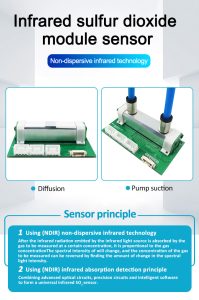Gas sensors play a crucial role in various industries and applications, enabling the detection and monitoring of different gases in the environment. These sensors are designed to identify specific gases and provide real-time data on their concentration levels. Gas sensors find applications in a wide range of fields, from industrial processes and environmental monitoring to safety and healthcare. In this article, we will explore the main applications of gas sensors and how they contribute to different sectors.

Industrial Processes and Emissions Monitoring
Gas sensors are extensively used in industrial processes to ensure safety, control emissions, and optimize operations. In manufacturing plants, gas sensors are deployed to detect hazardous gases such as hydrogen sulfide (H2S), carbon monoxide (CO), and volatile organic compounds (VOCs). By continuously monitoring these gases, early warning systems can be activated, preventing accidents and ensuring worker safety.
Gas sensors also aid in emissions monitoring
and compliance with environmental regulations. Industries that emit pollutants, such as power plants, refineries, and chemical factories, use gas sensors to measure and control emissions. This helps in minimizing the impact on the environment and ensuring compliance with air quality standards.
Environmental Monitoring Gas sensors
are vital instruments for monitoring air quality and detecting pollutants in the environment. They are used in urban areas, industrial zones, and even residential settings to measure the concentration of harmful gases. Common applications include monitoring nitrogen dioxide (NO2) and ozone (O3) levels near roadways, detecting sulfur dioxide (SO2) emissions from industrial sources, and tracking volatile organic compounds (VOCs) in indoor environments.
Environmental agencies
and researchers rely on gas sensors to collect accurate data on air quality, identify pollution sources, and develop effective mitigation strategies. Real-time monitoring with gas sensors enables prompt actions to address pollution issues and safeguard public health.
Safety and Fire Detection Gas sensors
are essential components of safety systems, particularly in settings where the presence of specific gases poses a risk. For instance, in coal mines and underground tunnels, gas sensors are used to detect dangerous levels of methane (CH4) and carbon monoxide (CO), providing early warnings to prevent explosions or suffocation.
Gas sensors also play a vital role in fire detection systems
They can detect combustion gases such as smoke, carbon monoxide, and hydrogen cyanide, helping to trigger alarms and initiate appropriate response measures. By rapidly detecting these gases, gas sensors contribute significantly to life safety in residential, commercial, and industrial buildings.
Medical and Healthcare Applications Gas sensors
find applications in the medical field, assisting in various diagnostic and monitoring procedures. For example, breath analysis using gas sensors can provide valuable information about a patient's health condition. This technique is used to detect gases associated with certain diseases, such as acetone for diabetes or ammonia for liver disorders.

Gas sensors are also utilized in anesthesia monitoring
to ensure the right concentration of gases during surgery. In addition, they aid in monitoring indoor air quality in healthcare facilities, detecting gases that may impact patient health or compromise sterile environments.
Automotive and Transportation Gas sensors
are integral to automotive systems, contributing to vehicle efficiency, emissions control, and driver safety. In modern vehicles, oxygen sensors monitor the level of oxygen in the exhaust gases, allowing the engine control unit to adjust the air-fuel mixture for optimal combustion and reduced emissions.
gas sensors are employed
in onboard diagnostics systems to detect and diagnose malfunctions in the vehicle's emission control system. This helps in identifying issues that may lead to increased pollutant emissions and ensures compliance with emission standards.
Conclusion Gas sensors
have diverse applications across numerous industries and sectors. From industrial processes and emissions monitoring to environmental surveillance, safety systems, healthcare, and automotive applications, gas sensors provide critical insights into the presence and concentration of various gases. The continuous advancement of gas sensor technologies enhances their accuracy, sensitivity, and reliability, enabling better control, improved safety, and smarter decision-making in a wide range of fields.
 : +86 155 8830 2704
: +86 155 8830 2704 : jxdziot@gmail.com
: jxdziot@gmail.com
